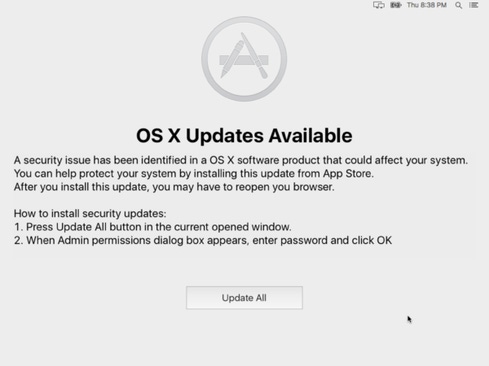Phishing-deployed malware can capture account credentials for any website users log into.

A surprisingly sophisticated new piece of Mac malware, called OSX.Dok, uses sophisticated means to monitor—and potentially alter—all HTTP and HTTPS traffic to and from the infected Mac. This means that the malware is capable, for example, of capturing account credentials for any website users log into, which offers many opportunities for theft of cash and data.
The malware was discovered by Check Point, in the form of a file named Dokument.zip, which was found being emailed to victims in phishing emails. Victims primarily have been located in Europe.
This “document” is, of course, actually an application. The app will obscure the entire screen with a fake update notification.
If the user clicks Update All and provides an admin password, the malware will finish installing, though it will take some time.
Among other things, two files will be installed in the user’s LaunchAgents folder to redirect this traffic. These are named com.apple.Safari.pac.plist and com.apple.Safari.proxy.plist. These files will help the malware redirect all web traffic through a malicious proxy server.
Once all this is complete, the malware deletes itself, leaving behind few obvious signs of its presence beyond the two deceptively-named launch agents.
Removal
Removing the two aforementioned LaunchAgents files is sufficient to disable the malware, but there are many leftovers and modifications to the system that cannot be as easily reversed, including:
Changes to the sudoers file
Installation of an untrustworthy root certificate
Installation of a legitimate LaunchAgents file named homebrew.mxcl.tor.plist
Installation of numerous legitimate command-line tools, consisting of tens of thousands of files
Malwarebytes Breach Remediation for Mac will detect the important components of this malware as OSX.Dok, disabling the active infection. However, when it comes to the other changes, which introduce vulnerabilities and potential behavior changes that are not easily reversed, additional measures will be needed. For people who don’t know their way around in the Terminal and the arcane corners of the system, it would be wise to seek the assistance of an expert, or erase the hard drive and restore the system from a backup made prior to infection.
The impact on business could be severe, as it could expose information that could allow an attacker to gain access to company resources. For example, consider the potential damage if an infected employee visited an internal company page providing instructions for how to connect to the company VPN and access internal company services. The malware would have sent all that information to the malicious proxy server.
If you have been infected by this malware in a business environment, you should consult with your IT department, so they can be aware of the risks and begin to mitigate them.
Apple has already revoked the certificate used to sign the app, so, at this point, anyone who encounters this malware will be unable to be infected by it.
Read the full post on Malwarebytes Labs
About the Author(s)
You May Also Like
The fuel in the new AI race: Data
April 23, 2024Securing Code in the Age of AI
April 24, 2024Beyond Spam Filters and Firewalls: Preventing Business Email Compromises in the Modern Enterprise
April 30, 2024Key Findings from the State of AppSec Report 2024
May 7, 2024Is AI Identifying Threats to Your Network?
May 14, 2024
Black Hat USA - August 3-8 - Learn More
August 3, 2024Cybersecurity's Hottest New Technologies: What You Need To Know
March 21, 2024




